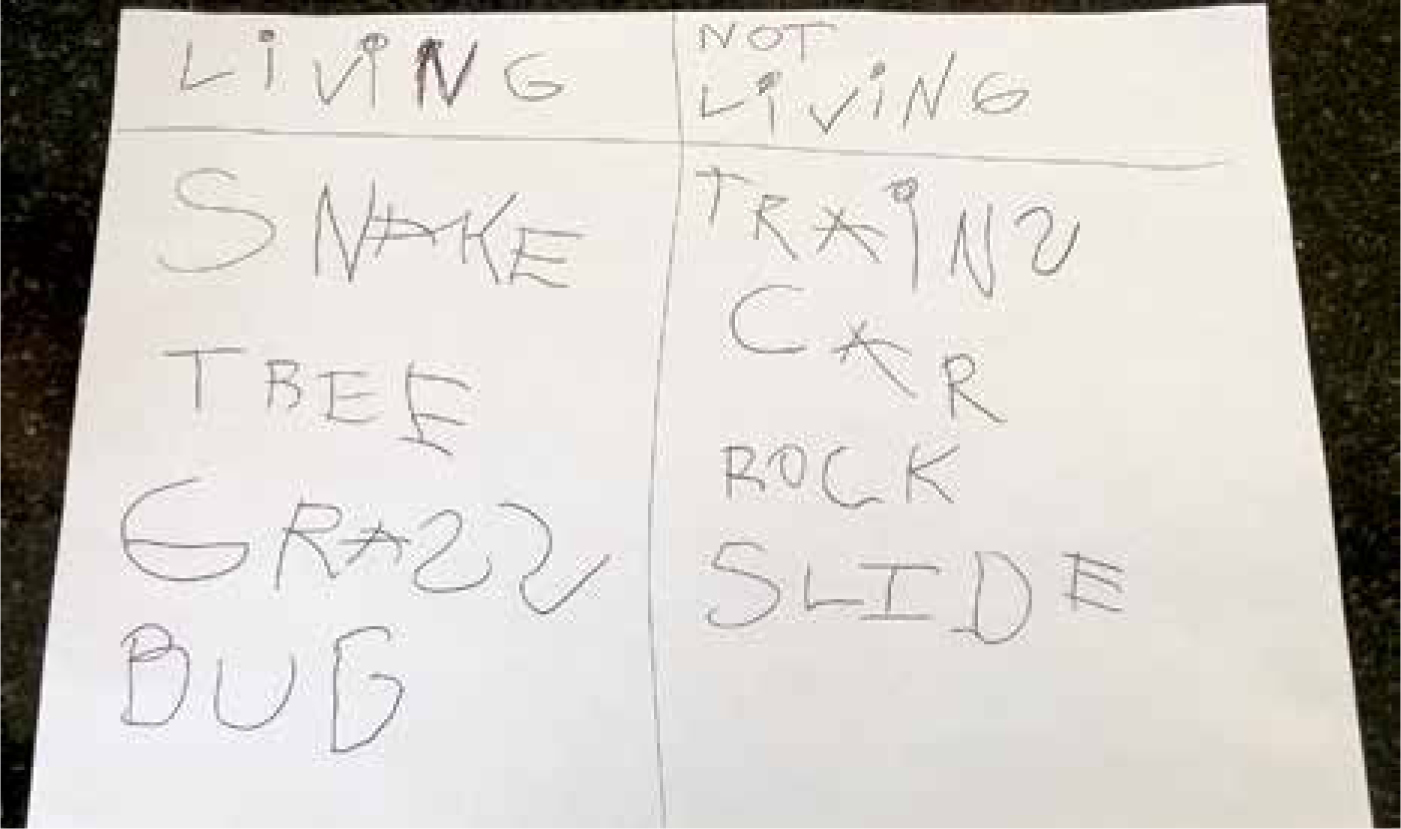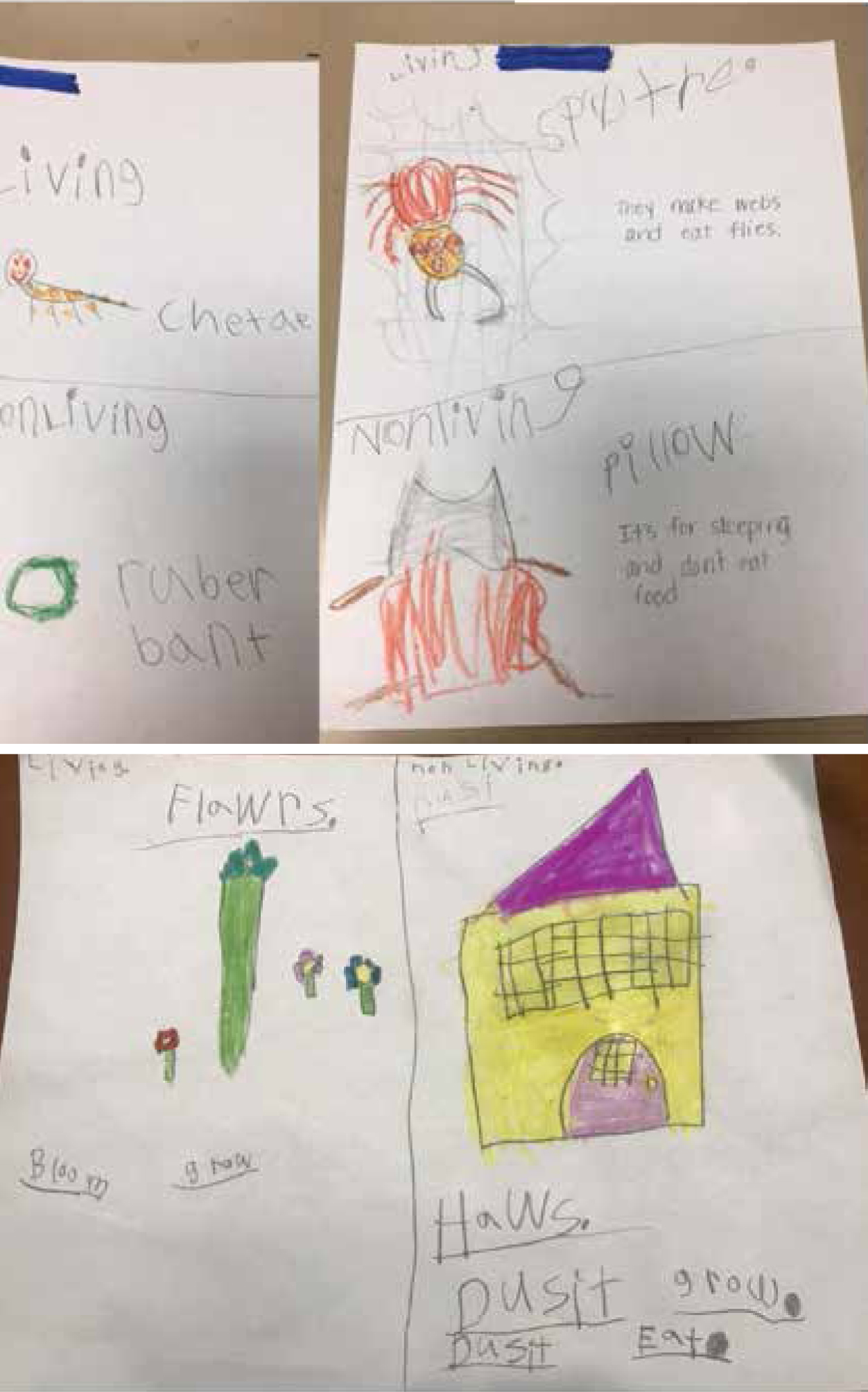It’s Alive?!?
Accurately modeling how science works using patterns in a kindergarten classroom.
Elementary students often have difficulty determining what makes something living and what those living things need to survive (Driver et al. 2015). For example, when I asked my kindergarten students, “How do you know if something is alive?”, they often responded with simple, overgeneralized answers such as, “It moves,” “It has a heart,” “It eats food,” and so on. While my curriculum standard related to the needs of plants and animals (K-LS1), I realized that I needed to first help students understand the difference between living and nonliving before I could help them deeply understand what is required to live. Although some believe inquiry-based instruction is unstructured or chaotic, carefully guiding students’ thinking during inquiry-based instruction helps students make sense of their investigations (Wilcox, Kruse, and Clough 2015).
Engaging students in the science and engineering practices that are part of scientific inquiry was initially difficult for kindergarten students because they often want to be told what to do and want to do it exactly right the first time. However, science rarely works this way. Therefore, I chose to ask higher- order questions and have the students investigate and draw conclusions. Wilcox and Kruse (2012) note that teachers can promote such higher-order thinking by not confirming or denying student claims, asking students to explain their thinking, providing opportunities for multiple experiences or models of concepts, and using students’ ideas to drive learning. Gooding and Metz (2011) offer additional strategies and ideas for teachers to use, including developing activities and discussions to create cognitive conflict, organizing instruction, and providing multiple examples and models. With these strategies and frameworks in mind, students were engaged with a sorting activity that was structured to teach them the difference between living and nonliving and address the crosscutting concept of patterns.
Day 1: Investigating to Develop Patterns
I engaged my students in collaborative group work for the first two lessons to have them discuss and classify pictures of living and nonliving things. The students were split into groups of two or three and were presented with a bag filled with picture cards. I try to keep the group sizes small for classroom management purposes and to encourage all students to remain engaged. During any small-group activity, I am also sure to move around the room to check in with groups and redirect when necessary. I made the picture cards by simply googling nonliving objects (e.g., refrigerator, fan, marble, flip-flop) and living things (e.g., grass, lion, baby, sunflower, elephant, spider) and selecting realistic pictures rather than drawings or clip art. I printed the images and then had enough for each group to have a set of pictures that were randomly mixed and ready to sort. While pictures allow for a wider variety of objects, if some students have visual impairments, I bring in the real objects when possible (e.g., grass, marbles, leaves, rocks). I told students to sort, or classify, the cards into two groups. Students were encouraged to discuss with their group members how to sort them (as I gave no classifiers) and I circulated among the groups.
Some of the classification systems the groups came up with included: animals and not animals, metal and not metal, inside and outside, animals and inside, animals and things, and electric and not electric. During this initial sort, I walked around and posed questions to small groups such as: How do you decide where to put things? What might be another way you could sort/classify? What items were you unsure of how to sort and why? How do you think your organization will be different if you sort things into living and nonliving? What patterns do you notice?
By asking these questions, I encouraged students to create alternative ways to sort the cards. We finished the first lesson by drawing students’ attention to how the activity models what scientists do. I asked, “Why do you think scientists sort or classify things into groups?” “What are some things scientists might try to group?” Students noted that sorting can help organize things and help scientists see how things are similar or different. They mentioned scientists might try to group dinosaurs, animals, plants, and rocks.
Day 2: Picture Sort of Living and Nonliving
On the second day of the lesson, I had students briefly review how they organized their pictures. I then displayed a picture of three living things (i.e., a dog, spider, plant) and asked, “What makes these things similar?” After students discussed ideas with their partners, they agreed all of them were alive. I then said, “Today I want you to sort the picture cards into living and nonliving things.” As students worked in small groups, I noticed they had the most debate, disagreement, and confusion over where to place the flower, tree, sprout, and grass picture cards. While circulating among the groups I heard comments such as, “Anything that needs water is alive,” “…but it doesn’t move unless the wind blows it,” “A cookie isn’t living because it can’t talk … a tree can’t talk either but it can grow so it’s living,” “A tree doesn’t breathe so it’s not living,” and more. I posed questions to small groups while I was circulating to help them clarify their thinking such as: What can a cat do that a rock cannot? How do you know a car is not living, even though it moves? What do babies need to live and grow? If spiders don’t talk, then why are they still alive?
These questions helped to challenge students’ ideas and helped them refine their thinking regarding the characteristics of living and nonliving things.
Day 3: Developing a Checklist
After the previous investigations, I used Living or Nonliving by Abbie Dunne (2016) to assist my instruction. This book provides engaging, real photographs, yet is simple enough for the students to understand and begin to recognize the characteristics of living and nonliving things. I chose to read the text after students engaged in the collaborative group work and sorting because they could draw on their experiences sorting while trying to make sense of the text.
After reading the nonfiction text about living and nonliving, my goal was for the students to develop and create a checklist to help them determine if something is living or nonliving. To get the discussion going, I first asked students how they decided what went into their living and nonliving sorts. Student responses included ideas about movement, growth, and food/fuel. As students mentioned ideas, I documented them on the whiteboard. To help students think more about movement, I referred back to the text we had read and asked questions like, “Why is a car not living?” Students realized even though it moves it, it doesn’t grow or eat and therefore movement cannot be a key characteristic of a living thing.
I then asked guiding questions that helped students add on to their list. For example, I asked students “What happens if we forget to water our plants?” When the students note that, “they die,” I use this idea to go further by asking, “if plants and animals eventually die, why will there still be plants and animals 100 years from now?” The students sometimes need to talk to a partner about this question, but eventually students explain that the animals have babies and plants make seeds to make new plants. After this short discussion, we make a new checklist for living things. In the second iteration, students included “eat,” “drink,” “grow,” and “make new ones” (reproduce).
Day 4: Applying Their Checklist
After collaboratively developing our checklist, students applied their ideas. To do this, students worked on graphic organizers (e.g., t-chart organizers [see Figure 1] and Venn diagrams), went outside to observe and collect items (leaves, grass, twigs, bugs, and so on), and discussed their collections with peers going through their class-created checklist to determine if the items were living or nonliving. Importantly, prior to students collecting items, we discussed how they can stay safe and what not to pick up, and we have students wash their hands when they return to the classroom.

During this application time, students sometimes encounter difficult items (e.g., a dead bug or an old exoskeleton). When students ask about such an item, we try hard to not simply answer the students’ question for them. Instead, we ask, “Why do you think it might go in the living category?” and “Why might it go in the non-living category?” Students typically note that the thing used to be alive, but isn’t any more, so we ask them to think about their checklist. When comparing to their checklist, student recognize that the dead bug no longer eats, drinks, grows, or reproduces.
Day 5: Crosscutting Concepts and Nature of Science
The living and nonliving activities concluded by revisiting the original picture cards. When the students sorted the picture cards this time, I noticed they were asking questions such as, “Does it make new ones or have babies?” “Does it grow?” “Does it need sunlight or water?” and making comments such as, “The tree grows and drops apples with seeds to the ground and then it starts again, so it’s alive.”
Upon completion of the final picture sort, the students gathered for a whole-group discussion and I asked questions to target nature of science ideas and the crosscutting concept of Patterns. Some questions I asked and some student responses included: “What evidence or clues helped you decide which things were living or nonliving?” “Living things move, but some things move that aren’t alive like cars. But cars don’t need food.” “Why do scientists use evidence?” “They use evidence to explain how things work.” “You changed your mind about where some of the cards belong (living or nonliving). Why do you think scientists change their thinking sometimes?” “Because that can make them better scientists. Just like practicing helps us be better.” “How is your sorting like a pattern?” “Patterns are like A,B,A,B,A,B. Putting things in groups is kind of like that.” “How do you think scientists use patterns?” “I think they do that so they can learn about new things in the future.” “How is what you did—sorting, investigating, and discussing—like what scientists do?”’ “I think they can learn about things in lots of kinds of ways.” “They talk to each other and learn.”
Assessing Students’ Thinking
To assess the students, I used a draw, write, and explain activity. I asked the students (individually) to draw a picture of something they knew was living and something that is nonliving (see Figure 2). I then asked them to write and explain how they knew the thing was living or nonliving using the characteristics, or traits, of living things to guide their explanations. I evaluated student work by noting whether they could correctly identify living and nonliving things and whether their explanation accurately reflected the checklist created by the class. This data is used to determine if students are still developing or are proficient with respect to their understanding of living and nonliving things. For example, if a student accurately identifies living and nonliving things but struggles to connect their thinking to the checklist, I document their understanding as still developing. However, I am sure to ask students to verbally explain to accommodate students who are still developing writing skills. Oftentimes, students verbally make connections to our class-developed checklist and some students even go well beyond to talk about “a pumping heart” or specifically note that flowers make blooms to produce seeds.

Conclusion
As part of the Next Generation Science Standards (K-LS1-1), students are expected to develop an understanding of what living things need in order to live and grow. Understanding the difference between living and nonliving through the above lessons provides important background knowledge to help students work toward the standard. By developing their key indicators of what makes something living, students were able to use patterns in at least two different contexts and compare/contrast their work in the two activities. By including content learning beyond the targeted disciplinary core idea (DCI), students developed a deeper understanding of the crosscutting concept patterns, developed a deeper understanding of the DCI and how scientists work, as well as engaged in scientific practices such as asking questions, analyzing and interpreting data through our work with patterns and by engaging in argument from evidence.
Life Science Crosscutting Concepts Science and Engineering Practices Early Childhood Preschool



